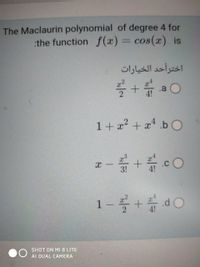
Calculus: Early Transcendentals
8th Edition
ISBN: 9781285741550
Author: James Stewart
Publisher: Cengage Learning
expand_more
expand_more
format_list_bulleted
Question

Transcribed Image Text:The Maclaurin polynomial of degree 4 for
the function f(x) = cos(x) is
%3D
اخترأحد الخیارات
x2
.a
4!
1+ a + x* _b O
3!
.C
4!
|-
SHOT ON MI8 LITE
AI DUAL CAMERA
Expert Solution
This question has been solved!
Explore an expertly crafted, step-by-step solution for a thorough understanding of key concepts.
This is a popular solution
Trending nowThis is a popular solution!
Step by stepSolved in 2 steps with 2 images

Knowledge Booster
Learn more about
Need a deep-dive on the concept behind this application? Look no further. Learn more about this topic, calculus and related others by exploring similar questions and additional content below.Similar questions
- Show that the function f(x)= x^3 − 15 cos(pi x) + 1 has three zeros in the interval [−4, 4]. Donot solve for the zerosarrow_forwardConsider the functions: f(x) = (cos(x) − sin(x))/cos(2x) and g(x) = 1/(cos(x) + sin(x)) where in both cases the domain consists of those real numbers where the denominator is not zero. Are f and g equal?arrow_forwardLet f(x) = 2x - 1 The smallest positive number for which f (cos (f(x))) = 0 is x = Hint: Begin by using the definition of f to remove f from the equation. Then solve a linear equation for cos(2x - 1). Then solve for x.arrow_forward
- Find all the x-intercepts of f(x)=cos(x) on the interval [0,2π)arrow_forwardFind a and d for the function f(x) = a cos(x) + d such that the graph of f matches the figure. a = |2 d = |-1 4- y 3- 2- 1 - 2n - ITarrow_forwardConsider the function f(x) = 6x + 12 sin x on the domain [0, 2π]. Use analytic techniques (calculus, algebra, trigonometry) to determine the intervals where the function is increasing and decreasing. Use exact values in your response. f(x) is increasing on f(x) is decreasing onarrow_forward
- Find F as a function of x and evaluate it at x = 0, x = T/4, and x = T/2. F(x) cos 0 do F(x) F(0)arrow_forward(3) Compute an approximation of f(x) = tanx by computing the coefficients Co, C₁, C2, C3 (a = 0). Then graph y = tan x and the obtained cubic polynomial in the same coordinate system. As you zoom on the origin (0, 0) do these two graphs get closer?arrow_forwardFind and verify the operator that annihilates the function f(x)=e-²x sinxarrow_forward
arrow_back_ios
arrow_forward_ios
Recommended textbooks for you
 Calculus: Early TranscendentalsCalculusISBN:9781285741550Author:James StewartPublisher:Cengage Learning
Calculus: Early TranscendentalsCalculusISBN:9781285741550Author:James StewartPublisher:Cengage Learning Thomas' Calculus (14th Edition)CalculusISBN:9780134438986Author:Joel R. Hass, Christopher E. Heil, Maurice D. WeirPublisher:PEARSON
Thomas' Calculus (14th Edition)CalculusISBN:9780134438986Author:Joel R. Hass, Christopher E. Heil, Maurice D. WeirPublisher:PEARSON Calculus: Early Transcendentals (3rd Edition)CalculusISBN:9780134763644Author:William L. Briggs, Lyle Cochran, Bernard Gillett, Eric SchulzPublisher:PEARSON
Calculus: Early Transcendentals (3rd Edition)CalculusISBN:9780134763644Author:William L. Briggs, Lyle Cochran, Bernard Gillett, Eric SchulzPublisher:PEARSON Calculus: Early TranscendentalsCalculusISBN:9781319050740Author:Jon Rogawski, Colin Adams, Robert FranzosaPublisher:W. H. Freeman
Calculus: Early TranscendentalsCalculusISBN:9781319050740Author:Jon Rogawski, Colin Adams, Robert FranzosaPublisher:W. H. Freeman
 Calculus: Early Transcendental FunctionsCalculusISBN:9781337552516Author:Ron Larson, Bruce H. EdwardsPublisher:Cengage Learning
Calculus: Early Transcendental FunctionsCalculusISBN:9781337552516Author:Ron Larson, Bruce H. EdwardsPublisher:Cengage Learning

Calculus: Early Transcendentals
Calculus
ISBN:9781285741550
Author:James Stewart
Publisher:Cengage Learning

Thomas' Calculus (14th Edition)
Calculus
ISBN:9780134438986
Author:Joel R. Hass, Christopher E. Heil, Maurice D. Weir
Publisher:PEARSON

Calculus: Early Transcendentals (3rd Edition)
Calculus
ISBN:9780134763644
Author:William L. Briggs, Lyle Cochran, Bernard Gillett, Eric Schulz
Publisher:PEARSON

Calculus: Early Transcendentals
Calculus
ISBN:9781319050740
Author:Jon Rogawski, Colin Adams, Robert Franzosa
Publisher:W. H. Freeman


Calculus: Early Transcendental Functions
Calculus
ISBN:9781337552516
Author:Ron Larson, Bruce H. Edwards
Publisher:Cengage Learning